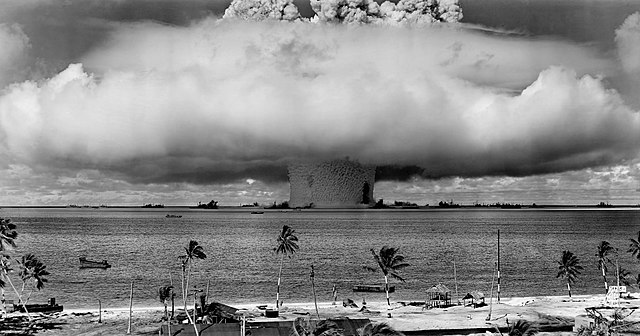Nuclear disarmament is the act of reducing or eliminating nuclear weapons. Its end state can also be a nuclear-weapons-free world, in which nuclear weapons are completely eliminated. The term denuclearization is also used to describe the process leading to complete nuclear disarmament.
The mushroom cloud over Hiroshima after the dropping of the atomic bomb nicknamed 'Little Boy' (Atomic bombings of Hiroshima and Nagasaki in 1945).
Mushroom-shaped cloud and water column from the underwater nuclear explosion of July 25, 1946, which was part of Operation Crossroads.
November 1951 nuclear test at the Nevada Test Site, from Operation Buster, with a yield of 21 kilotons. It was the first U.S. nuclear field exercise conducted on land; troops shown are 6 mi (9.7 km) from the blast.
1952 World Peace Council congress in East Berlin showing Picasso peace dove above the stage
Nuclear proliferation is the spread of nuclear weapons, fissionable material, and weapons-applicable nuclear technology and information to nations not recognized as "Nuclear Weapon States" by the Treaty on the Non-Proliferation of Nuclear Weapons, commonly known as the Non-Proliferation Treaty or NPT. Proliferation has been opposed by many nations with and without nuclear weapons, as governments fear that more countries with nuclear weapons will increase the possibility of nuclear warfare, de-stabilize international or regional relations, or infringe upon the national sovereignty of nation states.
In 2003, Libya admitted that the nuclear weapons-related material including these centrifuges, known as Pak-1, were acquired from Pakistan





